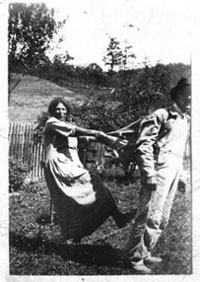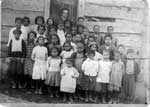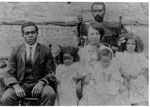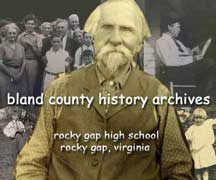
Charles & Mary Gray Robinson on
Dry Fork circa 1925

Dry Fork the Place
Pete Ferguson Homecoming

The History of Dry Fork
The Story of Dry Fork:The Early Years

The Interviews
An oral history and technology project of the
Bland County History Archives
Dry Fork is home to Bland County's only African American community. It is located at the head of Dry Fork Valley and nestles between East River and Buckhorn Mountains. It was settled in the latter part of the 19th century by families from Bland, Pulaski, Tazewell, Floyd and Franklin counties. They came looking for land to farm and a quiet place to raise their families. Land was freedom and the one sure guarantee of freedom. The land had not been cleared and was purchased for a dollar an acre. In 1880 M. H. Ferguson and A.J. Tynes were among the first families to move up Dry Fork. A few years later Powell Saunders came from the Willis section of Floyd County and built a sawmill that was powered by a steam engine.
Dry Fork Creek also ran a grain mill. A one room school house was established soon after. Land was donated for the Tynes Chapel AME church at the turn of the century, but the congregation met in the school house until construction was completed. MacDaniel Ferguson and others were sent to the Christiansburg Institute and worked his way to an education and came back and raised a family.Dry Fork soon became a thriving community with the Showalter, Charlton, Gore, Hogan, Blair, Robinson, and other families arriving. There was trade across East River Mountain to Ingleside, W.V. and to the Round Bottom section of Bland County over Buckhorn Mountain. Agriculture produce and lumber was taken to Rocky Gap and shipped out on the railroad. There were several small stores that supplied the needs of the residents. Heavy snows would often cut the community off from the rest of the world. When the school house closed in the early 1950's segregation in Virginia forced the community to send their children to a black school in Tazewell County. Race relations in the Rocky Gap section have always been good. In fact Andrew Ferguson was the barber in Rocky Gap for many decades. It was one of the few barbershops in the South with a black barber and a white shoe shine boy. Integration was accomplished peacefully in the 1960's at the Rocky Gap Combined School.
Over the years Dry Fork, like most rural communities, has suffered the problem of losing its young people to the job opportunities of urban areas. Many that have moved away are now returning and building homes on the land that once attracted their ancestors.
Explore the family ties in this extensive Reunion genealogical database.
This is a work in progress. It will be updated often in the coming months.
Visit Restoring the Voices , a directory and repository of Southwest Virginia African American history and culture.
The Bland County History Archives is an oral history and technology project of Rocky Gap High School in Rocky Gap, Virginia. Its roots are place and community based. Over 400 interviews and more than a thousand photos have been compiled during the last decade. To learn more click on the photo above.
The research work on the history and genealogy of the Dry Fork community by Denise Smith and John Dodson has received support from the Virginia Foundation of the Humanities and Public Policy, as part of its African-American History Initiative and the African-American Trails project which is being developed in partnership with the Virginia Tourism Authority. Through these programs, the Foundation and the VTA seek to increase understanding of African-American history in Virginia; to promote research and documentation of existing African-American history in the state; and to encourage Virginians as well as people from all parts of the nation and the world to visit these sites.

